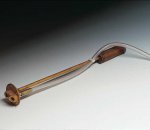superheat6k
Well-known member
I was recently asked how I made my fuel filtration rig.
I don't use additives and I don't expect to suffer fuel related breakdown. Instead I keep the fuel dry and clean - here's how ...
The set up is quite straightforward to understand.
On each system there are three connection points, each with a female instant connector.
1 Tank low point drain. On my boat these are hidden away at the aft end with large gate valve. Ive connected a copper 3/8" tube via adaptors and led this along side the engine adjacent to the fwd end, with a 3/8" ball valve to the female instant connector. The valve is clamped down.
2 Spill return line. I've fitted a 3/8" tee on the fuel return pipe from the fuel pump and injector spills, with a pipe running again to the fwd end of the engine - at deck head level. Another ball valve and instant female.
3 Fuel filter inlet pipe from tank. Another 3/8" tee ditto the spill line set up.
The rig itself is a Baldwin Fuel oil filter / coalescer with a Holley 12vdc fuel pump. The inlet passes first into the Baldwin filter and then on to the pump. Each of the inlet and outlets is on to a section of rubber fuel quality hose ending in the matching instant connector Males. It is important to filter first and pump second, because the pump smashes water drops into tiny particles which will pass through the coalescer filter.
I have a power supply that the filter plugs into nearby with a simple switch.
The rig can draw from either the fuel pickup or low point drain. It can discharge into either the spill return or the fuel filter inlet.
Being able to discharge into the fuel pickup line has several advantages ...
a. This partially pressurises the pickup line, which makes pre-filling fuel filters or priming the fuel system a doddle. Set it up and turn it on, then vent filters and bleed the system at you leisure.
b. If a slug of crud were to block the pick up then this effectively blows the crud back into the tank.
c. I can if necessary direct feed the engine, should the engine fuel lift pump fail.
Also it is possible to draw from one and flow to the other tank.
For routine polishing draw from the low point and return via the spill and simply leave it to circulator ~1-2 hours. A check of the fuel bowl on the filter shows any water or contaminate settled out at the bottom.
This is the list of parts - ~ £350 ...
Here is a kit of parts, but note I have found a cheaper filter and pump (not tested for this application) ...
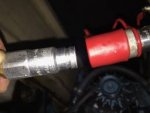
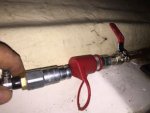
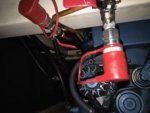
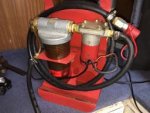
I don't use additives and I don't expect to suffer fuel related breakdown. Instead I keep the fuel dry and clean - here's how ...
The set up is quite straightforward to understand.
On each system there are three connection points, each with a female instant connector.
1 Tank low point drain. On my boat these are hidden away at the aft end with large gate valve. Ive connected a copper 3/8" tube via adaptors and led this along side the engine adjacent to the fwd end, with a 3/8" ball valve to the female instant connector. The valve is clamped down.
2 Spill return line. I've fitted a 3/8" tee on the fuel return pipe from the fuel pump and injector spills, with a pipe running again to the fwd end of the engine - at deck head level. Another ball valve and instant female.
3 Fuel filter inlet pipe from tank. Another 3/8" tee ditto the spill line set up.
The rig itself is a Baldwin Fuel oil filter / coalescer with a Holley 12vdc fuel pump. The inlet passes first into the Baldwin filter and then on to the pump. Each of the inlet and outlets is on to a section of rubber fuel quality hose ending in the matching instant connector Males. It is important to filter first and pump second, because the pump smashes water drops into tiny particles which will pass through the coalescer filter.
I have a power supply that the filter plugs into nearby with a simple switch.
The rig can draw from either the fuel pickup or low point drain. It can discharge into either the spill return or the fuel filter inlet.
Being able to discharge into the fuel pickup line has several advantages ...
a. This partially pressurises the pickup line, which makes pre-filling fuel filters or priming the fuel system a doddle. Set it up and turn it on, then vent filters and bleed the system at you leisure.
b. If a slug of crud were to block the pick up then this effectively blows the crud back into the tank.
c. I can if necessary direct feed the engine, should the engine fuel lift pump fail.
Also it is possible to draw from one and flow to the other tank.
For routine polishing draw from the low point and return via the spill and simply leave it to circulator ~1-2 hours. A check of the fuel bowl on the filter shows any water or contaminate settled out at the bottom.
This is the list of parts - ~ £350 ...
Here is a kit of parts, but note I have found a cheaper filter and pump (not tested for this application) ...
| Item | Make details | Model | Qty | Ebay | Price | |
| Rack | Imagination | 1 | ||||
| Filter assy | Racor 500 copy | 1 | 393074412399 | £24 | £24 | |
| Filter element | Racor 500 copy | 1 + Spare | 283571129306 | £7 | £14 | |
| Filter adaptor | As required - might come with filter | to suit 3/8” hose | 2 | £0 | ||
| Pump | Holley or similar | 1 | 323267905619 | £22 | £22 | |
| Pump adaptor | to suit pump size > 3/8” compression | 2 | £0 | |||
| Hose 3/8” | Suitable for diesel fuel | 6m | 265215557691 | £4 | £24 | |
| Dripless Instant connectors | https://www.flowfitonline.com/hydraulic-qrcs-and-adaptors/quick-release-couplings/hydraulic-flat-face-quick-release-couplings-set-12-bsp-dn08-iso-125-350-bar-rated-45-lmin | 6 | £20 | £120 | ||
| Hose adaptor | 3/8” hose barb > 3/8” BSPP | 2 | £5 | £10 | ||
| Seal washer | Dowty type to suit 3/8” BSPP fitting | lots | £10 | £10 | ||
| Drain point adaptor | e.g. 1” BSPTM to 3/8” compression | 2 | £5 | £10 | ||
| Copper tube | measure what your boat uses 3/8” and 10mm are close but not the same | 10m | £3 | £30 | ||
| Tee | 3/8” > 3/8” > 3/8” compression | or 10mm | 4 | £6 | £24 | |
| Ball valves | 3/8" compression or extra fittings as necessary to allow it to fit to a 3/8” pipe | or 10mm | 6 | £6 | £36 | |
| Cigarette plug & socket | Euro style is more positive or marine 2 pole type. Bulgin Buccaneer is the best make. | 1 plug & socket | £10 | £10 | ||
| Switch | Can be on the cable | 1 | £5 | £5 | ||
| £339 | ||||||





